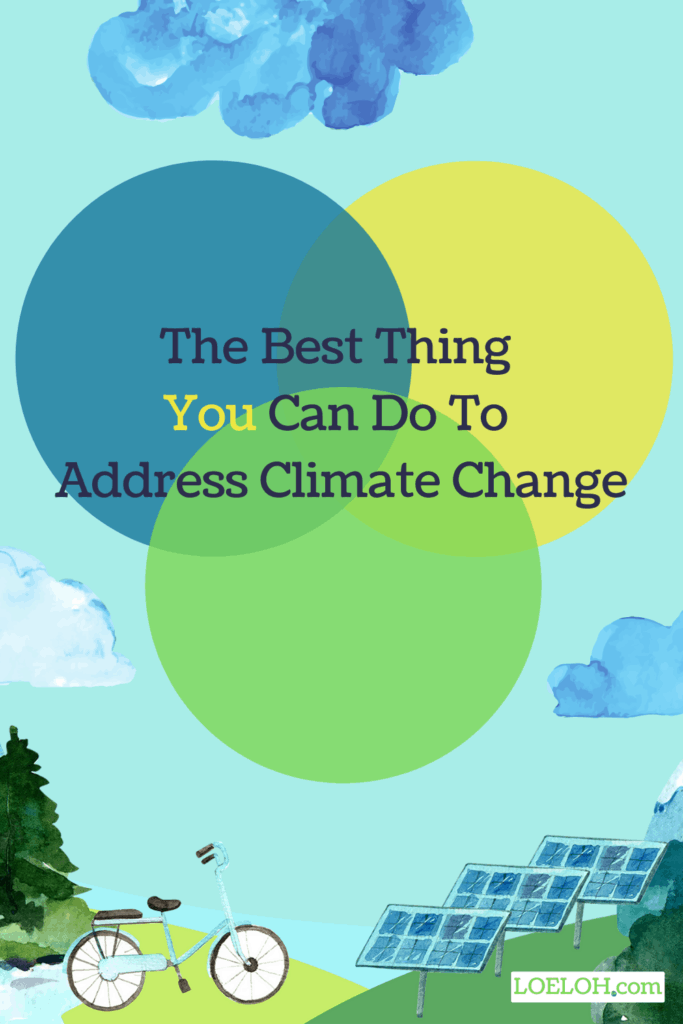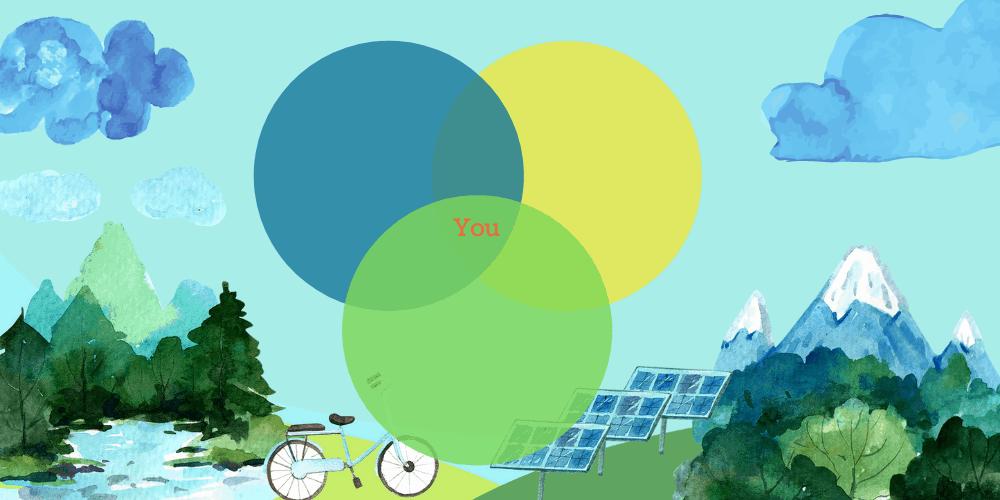What is the best thing you and I can do to address climate change? Loeloh was started because I wanted to learn the answer to this question too.
That wasn’t my first question though. The question I initially asked was, “What is the best thing I can do as an individual for Earth?” Early on, through my laypersons research, I quickly found changing to LED light bulbs and alternatives to plastic straws as possibilities. These are steps to reducing energy use and decreasing plastic waste. For me though, they were not satisfying offsets to the magnitude of environmental issues across the planet. Digging a little deeper led me to the most pressing matter of our time, the feat of addressing climate change.
The new question was now, “What is the best thing I can do to address climate change?” Rewriting the question gave me a two sided realization. The first was “Of stinking course,” and the other side was “Oooh No.” How can one single person address a global issue like climate change? Either mad to even attempt answering this question or mad NOT to, I pushed forward.
So here it goes. Below I will guide you through what I initially understood the best course of individual action was. Then we’ll go over systemic action towards addressing climate change. Lastly, we’ll review what really is the best thing you and I can do to address climate change.
Is Your Carbon Footprint The Best Thing You Can Do to Address Climate Change?
When I was first trying to figure out what an individual can do to address climate change, my search led me to carbon footprints. My own carbon footprint when I started LOELOH (early in 2020) was 21 tons a year. Since then, I’ve worked on eating more plant-rich meals, gardening, and composting to reduce my carbon footprint. These activities are good starting points. The top 5 things you and I can do to lower our individual carbon footprint are the following:
- Have fewer kids (controversial for sure, and may cover this in the future)
- Drive less or drive electric
- Fly less
- Make your home more energy efficient
- Switch to a plant-based diet
However, in the last half of 2020, I learned that the idea of our individual carbon footprints was endorsed by British Petroleum or BP. Ooh did this make me angry! BP is among the highest emitters of greenhouse gases in the world! The promotion of individuals lowering their own carbon footprints, shifted BP’s responsibility of reducing emissions to you and I. BP’s move stinks like a barrel of crude oil.
Similar to switching to LED lightbulbs, reducing our own carbon footprints does decrease greenhouse gas emissions. You know me already though, I wanted to dig a little deeper. Let’s look at the numbers of our singular carbon footprints compared to the world’s carbon footprint.
What About Systemic Action to Address Climate Change?
Every year, global greenhouse gas emissions are estimated to be about 50 BILLION tons. A study in 2017 found of that total only 100 companies are responsible for 71 percent of greenhouse gas emissions!!! BP is number eleven on that list.
The average carbon footprint of an adult in the United States (U.S.) is 16 tons. So how does the average adult’s carbon footprint compare to the world’s annual carbon footprint. The How to Save a Planet podcast’s team did the math for us. Are you ready for the number? In the U.S., the average adult’s individual carbon footprint is 0.0000000003% of the total global carbon footprint. That is NINE zeros. So practically zero percent!
Additionally, in 2018, the United Nations’ Intergovernmental Panel on Climate Change (IPCC) released the report that we have until 2030 to reduce our worldwide greenhouse gas emissions by HALF! They estimate that doing so could keep temperatures from rising about 1.5°C. It is looking like we may hit 1.5°C sooner. Considering the annual global greenhouse gas emissions, the 100 companies primarily responsible, and the timeline we have to work with, we need systemic action to address climate change now.
Really The Best Thing You and I Can Do to Address Climate Change
Now that we understand systemic action is needed and our own carbon footprint is a minuscule drop; what really is the best thing then that you and I can do to address climate change? Focus our strengths and work together for systemic change while not losing sight of our own carbon footprint. Let me explain.
The Value of Your Carbon Footprint You Can’t Calculate is…
If our individual carbon footprint is statistically insignificant against global greenhouse gas emissions why don’t we just forget about it completely? There are five thoughts to this point. First, as Dr. Katharine Wilkinson stated in the How to Save a Planet podcast, “My feeling is, thank goddess we don’t have to rely on every individual getting everything right in their own lives, because New Year’s resolutions don’t even last a month, you know?” This comes as a bit of a relief for me and hopefully for you too. Because this means that we do not have to depend on everyone reducing their carbon footprint to effectively address climate change.
Secondly, you and I also do not need to attain ‘perfection’ through reaching the lowest carbon footprint possible. Because our singular carbon footprints are tiny compared to the ginormous emissions from companies, and countries around the world.
Third, because our carbon footprints are so minute versus worldwide emissions, our daily decisions of reducing our emissions is less about the actual number of our carbon footprint and more about living our values. Dr. Wilkinson continues, “But anything that keeps us focused kind of moment to moment on the world that we want to create is a good thing, right? Like, I can’t vote three times a day, but I do eat three times a day. And I think every time we do these things, it gives us a chance to reflect on our values, reflect on our connection to the planet’s living systems, to think about what it is that we’re trying to do here.”
…the People You Invite to Join You.
Fourth our individual carbon footprint activities can move other people to take action too. For instance, when Greta Thunberg chose to sail across the Atlantic Ocean to New York City for the UN Climate Summit in 2019 rather than fly she did two things. One, she lead by example by choosing a carbon free mode of transportation, sailing. And two, her choice to avoid flying influenced others to think about their own flying habits.
In the episode of How to Save a Planet Podcast, host Dr. Ayana Elizabeth Johnson stated, “….think about your actions as a form of communication, as an invitation for others to join you, then your action can lead to other actions that can actually lead to change.” When we communicate our actions to address climate change with others be inviting and inclusive, rather than shameful or guilt ridden.
The fifth thought on our individual carbon footprints, is to maximize our efforts by expanding our circle. When we bring in more people to work with us towards the shared goal of lowering our collective carbon footprint it leads to a synergistic effect. For example, Dr. Wilkinson explained she worked to get compost services for her entire condo community. By doing this, she got 30 of her neighbors composting too. An added bonus was the compost services cost her less.
As Dr. Elizabeth Johnson advises, think about how you can bring your climate actions to one circle out from yourself. Would your neighborhood be interested in community rooftop solar? Would your apartment building benefit in improving energy efficiency? Does your school or work cafeteria provide plant-based meal options? What circle around you could you bring your carbon footprint work to?
Think in More Circles
Our climate actions can move us far beyond our carbon footprint to specifically what makes us powerful as individuals. Dr. Elizabeth Johnson ends the podcast episode advising us to find our individual climate super power with this Venn Diagram exercise. This exercise can help us sort out how we as individuals can make our greatest impact in addressing climate change.
The instructions below are from the How to Save a Planet podcast.
- Draw a Venn Diagram with 3 circles
- In one circle ask yourself: What are you good at? What are your skills?
- Second circle ask yourself: What work needs doing? What climate solution are you going to focus on? How does it overlap with the skills that you have?
- Third circle ask yourself: What brings you joy? Dr. Elizabeth Johnson explains, “Because this is the work of our lifetime. We need to do something that will sustain us.”
Consider the communities you are a part of. Reflect on where you can and want to bring your super power to the table in addressing climate change. Addressing climate change is much more than a science problem. Climate change is intertwined with our sprawling social injustices and environmental issues. If you do not think you have a super power to contribute to this global issue don’t be discouraged. Rather, read about how climate change is interconnected to just about every sector in our society. Now, more than ever, we need all of us working together.
Consider Even Bigger Circles.
If you are ready for even more action and bring about even bigger systemic change, join the Climate Movement. According to a study completed by the Yale Center for Climate Change Communication group about 26% of Americans are alarmed about climate change. You may consider yourself alarmed about climate change too. There are numerous organizations working to address climate change with global, national, state, and local groups that need you.
Addressing climate change is a colossal feat when we frame the endeavor as you and I doing the work alone. However, we are not alone. We need to bring our strengths to the cause and invite others to join us too. The best thing you and I can do to address climate change is to work collectively thinking bigger than ourselves.
Today, give yourself some time to complete the Venn Diagram exercise described above with the free worksheet. Also, check out the How To Save a Planet Podcast episode referenced frequently in this post. This episode crystalized my own answer to the best thing we can do as individuals to address climate change. If you haven’t already, subscribe to Loeloh’s email list to keep up to date on more information about how we can address climate change together and more.

Image Credit: Cloud Watercolor, By OneyWhyStudio, and Save the World Frame Concept Watercolor By WatercolorEpsStudio

